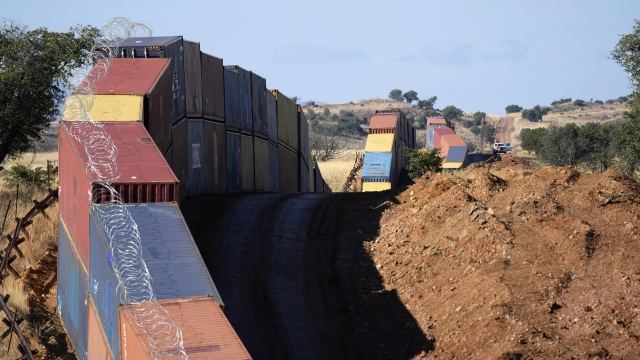In an Arizona national forest full of beauty and thriving with wildlife, unnatural changes stand out.
Myles Traphagen, the program coordinator at Wildlands Network Borderlands, an organization working to protect nature, points to a makeshift wall built from shipping containers at the U.S. border in Coronado National Forest as one of those eyesores. He also has concerns about its impact on wildlife.
"It's such an eyesore because this is so industrial," Traphagen said. "The Central Valley and the Huachuca Mountains are a hotbed for biodiversity, and this is a crucial migration corridor for many species here — the most notable of which is the jaguar."
Emily Burns, the program director with Sky Island Alliance, a nonprofit protecting wildlife and habitats, says video captured at Coronado National Forest shows the temporary wall disrupted wildlife crossings and scarred the protected environment that's been deemed an Arizona jewel. She now worries more wildlife habitats will be damaged in the process of removing the shipping boxes.
Burns credits community members who peacefully protested the wall for bringing construction to a halt.
"We think that in the last few weeks of the protests, they probably stopped a mile and a half of container wall from being built," Burns said.
The double-stacked container wall began going up in October. Now, less than three months later, a political battle with the U.S. government over authority and trespassing on federal land ended with former Arizona Republican Gov. Doug Ducey agreeing to stop operations and remove the containers.
Back in August, Gov. Doug Ducey ordered the placement of the old shipping boxes to close wall gaps along the Arizona-Mexico border, calling it a temporary response to an emergency crisis at the border.
The estimated $95 million job to place the 3,000 containers was about a third complete before it was called off.
Still, the containers still closed nearly a mile of gaps along Yuma County, Arizona, where migrant crossings ballooned in the last fiscal year and remain high.
"Those containers have been serving their purpose and restricting access into the United States," said Jonathan Lines, Yuma County District 2 Supervisor.
However, environmentalists say migrant crossings in that forest are uncommon.
The double-stacked containers are 22 feet tall and have razor wire on top, but some gaps are so big anyone can just walk through them.
"It's just such a huge waste of taxpayer money," Traphagen said.
State contracts released to Scripps News by environmentalists show it will cost taxpayers more than $75 million to remove the containers.
"It's not serving any purpose other than making a blight on the landscape and being a political stunt," said Kevin Kent, Arizona resident.
And some say that stunt dates back generations.
Kenneth Madsen, an associate professor of geography at Ohio State University who has studied border walls for decades, says border walls can help funnel migrants to one area, but overall, he finds them ineffective.
"Border walls have the appearance of being simple," Madsen said. "You put them up; you stop people. But in reality, they're just not as effective as people would like them to be, and they do have a lot of other unintended negative consequences."
As heavy machinery moves in to remove containers across the Arizona border, conservationists say they'll be monitoring every move in the process, which is expected to take several weeks.
"We're going to be looking at: Are they causing damage in the process?" Traphagen said.



